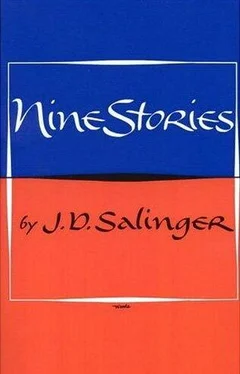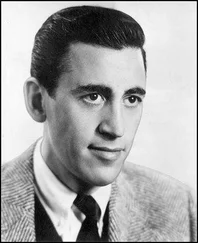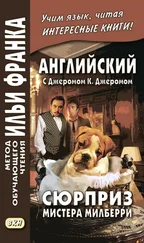Jerome Salinger - Nine Stories
Здесь есть возможность читать онлайн «Jerome Salinger - Nine Stories» весь текст электронной книги совершенно бесплатно (целиком полную версию без сокращений). В некоторых случаях можно слушать аудио, скачать через торрент в формате fb2 и присутствует краткое содержание. Год выпуска: 1953, Издательство: Little Brown, Жанр: Классическая проза, на английском языке. Описание произведения, (предисловие) а так же отзывы посетителей доступны на портале библиотеки ЛибКат.
- Название:Nine Stories
- Автор:
- Издательство:Little Brown
- Жанр:
- Год:1953
- ISBN:нет данных
- Рейтинг книги:4 / 5. Голосов: 2
-
Избранное:Добавить в избранное
- Отзывы:
-
Ваша оценка:
- 80
- 1
- 2
- 3
- 4
- 5
Nine Stories: краткое содержание, описание и аннотация
Предлагаем к чтению аннотацию, описание, краткое содержание или предисловие (зависит от того, что написал сам автор книги «Nine Stories»). Если вы не нашли необходимую информацию о книге — напишите в комментариях, мы постараемся отыскать её.
Nine Stories — читать онлайн бесплатно полную книгу (весь текст) целиком
Ниже представлен текст книги, разбитый по страницам. Система сохранения места последней прочитанной страницы, позволяет с удобством читать онлайн бесплатно книгу «Nine Stories», без необходимости каждый раз заново искать на чём Вы остановились. Поставьте закладку, и сможете в любой момент перейти на страницу, на которой закончили чтение.
Интервал:
Закладка:
Soon the Laughing Man was regularly crossing the Chinese border into Paris, France, where he enjoyed flaunting his high but modest genius in the face of Marcel Dufarge, the internationally famous detective and witty consumptive. Dufarge and his daughter (an exquisite girl, though something of a transvestite) became the Laughing Man’s bitterest enemies. Time and again, they tried leading the Laughing Man up the garden path. For sheer sport, the Laughing Man usually went halfway with them, then vanished, often leaving no even faintly credible indication of his escape method. Just now and then he posted an incisive little farewell note in the Paris sewerage system, and it was delivered promptly to Dufarge’s boot. The Dufarges spent an enormous amount of time sloshing around in the Paris sewers.
Soon the Laughing Man had amassed the largest personal fortune in the world. Most of it he contributed anonymously to the monks of a local monastery—humble ascetics who had dedicated their lives to raising German police dogs. What was left of his fortune, the Laughing Man converted into diamonds, which he lowered casually, in emerald vaults, into the Black Sea. His personal wants were few. He subsisted exclusively on rice and eagles’ blood, in a tiny cottage with an underground gymnasium and shooting range, on the stormy coast of Tibet. Four blindly loyal confederates lived with him: a glib timber wolf named Black Wing, a lovable dwarf named Omba, a giant Mongolian named Hong, whose tongue had been burned out by white men, and a gorgeous Eurasian girl, who, out of unrequited love for the Laughing Man and deep concern for his personal safety, sometimes had a pretty sticky attitude toward crime. The Laughing Man issued his orders to the crew through a black silk screen. Not even Omba, the lovable dwarf, was permitted to see his face.
I’m not saying I will, but I could go on for hours escorting the reader—forcibly, if necessary—back and forth across the Paris-Chinese border. I happen to regard the Laughing Man as some kind of super-distinguished ancestor of mine—a sort of Robert E. Lee, say, with the ascribed virtues held under water or blood. And this illusion is only a moderate one compared to the one I had in 1928, when I regarded myself not only as the Laughing Man’s direct descendant but as his only legitimate living one. I was not even my parents’ son in 1928 but a devilishly smooth impostor, awaiting their slightest blunder as an excuse to move in—preferably without violence, but not necessarily—to assert my true identity. As a precaution against breaking my bogus mother’s heart, I planned to take her into my underworld employ in some undefined but appropriately regal capacity. But the main thing I had to do in 1928 was watch my step. Play along with the farce. Brush my teeth. Comb my hair. At all costs, stifle my natural hideous laughter.
Actually, I was not the only legitimate living descendant of the Laughing Man. There were twenty-five Comanches in the Club, or twenty-five legitimate living descendants of the Laughing Man—all of us circulating ominously, and incognito, throughout the city, sizing up elevator operators as potential archenemies, whispering side-of-the-mouth but fluent orders into the ears of cocker spaniels, drawing beads, with index fingers, on the foreheads of arithmetic teachers. And always waiting, waiting for a decent chance to strike terror and admiration in the nearest mediocre heart.
One afternoon in February, just after Comanche baseball season had opened, I observed a new fixture in the Chief’s bus. Above the rear-view mirror over the windshield, there was a small, framed photograph of a girl dressed in academic cap and gown. It seemed to me that a girl’s picture clashed with the general men-only decor of the bus, and I bluntly asked the Chief who she was. He hedged at first, but finally admitted that she was a girl. I asked him what her name was. He answered unforthrightly, “Mary Hudson.” I asked him if she was in the movies or something. He said no, that she used to go to Wellesley College. He added, on some slow-processed afterthought, that Wellesley College was a very high class college. I asked him what he had her picture in the bus for, though. He shrugged slightly, as much as to imply, it seemed to me, that the picture had more or less been planted on him.
During the next couple of weeks, the picture—however forcibly or accidentally it had been planted on the Chief—was not removed from the bus. It didn’t go out with the Baby Ruth wrappers and the fallen licorice whips. However, we Comanches got used to it. It gradually took on the unarresting personality of a speedometer.
But one day as we were on our way to the Park, the Chief pulled the bus over to a curb on Fifth Avenue in the Sixties, a good half mile past our baseball field. Some twenty back-seat drivers at once demanded an explanation, but the Chief gave none. Instead, he simply got into his story-telling position and swung prematurely into a fresh installment of “The Laughing Man.” He had scarcely begun, however, when someone tapped on the bus door. The Chief’s reflexes were geared high that day. He literally flung himself around in his seat, yanked the operating handle of the door, and a girl in a beaver coat climbed into the bus.
Offhand, I can remember seeing just three girls in my life who struck me as having unclassifiably great beauty at first sight. One was a thin girl in a black bathing suit who was having a lot of trouble putting up an orange umbrella at Jones Beach, circa 1936. The second was a girl aboard a Caribbean cruise ship in 1939, who threw her cigarette lighter at a porpoise. And the third was the Chief’s girl, Mary Hudson.
“Am I very late?” she asked the Chief, smiling at him.
She might just as well have asked if she was ugly.
“No!” the Chief said. A trifle wildly, he looked at the Comanches near his seat and signalled the row to give way. Mary Hudson sat down between me and a boy named Edgar something, whose uncle’s best friend was a bootlegger. We gave her all the room in the world. Then the bus started off with a peculiar, amateur-like lurch. The Comanches, to the last man, were silent.
On the way back to our regular parking place, Mary Hudson leaned forward in her seat and gave the Chief an enthusiastic account of the trains she had missed and the train she hadn’t missed; she lived in Douglaston, Long Island. The Chief was very nervous. He didn’t just fail to contribute any talk of his own; he could hardly listen to hers. The gearshift knob came off in his hand, I remember.
When we got out of the bus, Mary Hudson stuck right with us. I’m sure that by the time we reached the baseball field there was on every Comanche’s face a some-girls-just-don’t-know-when-to-go-home look. And to really top things off, when another Comanche and I were flipping a coin to decide which team would take the field first, Mary Hudson wistfully expressed a desire to join the game. The response to this couldn’t have been more clean-cut. Where before we Comanches had simply stared at her femaleness, we now glared at it. She smiled back at us. It was a shade disconcerting. Then the Chief took over, revealing what had formerly been a well-concealed flair for incompetence. He took Mary Hudson aside, just out of earshot of the Comanches, and seemed to address her solemnly, rationally. At length, Mary Hudson interrupted him, and her voice was perfectly audible to the Comanches. “But I do,” she said. “I do, too, want to play!” The Chief nodded and tried again. He pointed in the direction of the infield, which was soggy and pitted. He picked up a regulation bat and demonstrated its weight. “I don’t care,” Mary Hudson said distinctly, “I came all the way to New York—to the dentist and everything—and I’m gonna play.” The Chief nodded again but gave up. He walked cautiously over to home plate, where the Braves and the Warriors, the two Comanche teams, were waiting, and looked at me. I was captain of the Warriors. He mentioned the name of my regular center fielder, who was home sick, and suggested that Mary Hudson take his place. I said I didn’t need a center fielder. The Chief asked me what the hell did I mean I didn’t need a center fielder. I was shocked. It was the first time I had heard the Chief swear. What’s more, I could feel Mary Hudson smiling at me. For poise, I picked up a stone and threw it at a tree.
Читать дальшеИнтервал:
Закладка:
Похожие книги на «Nine Stories»
Представляем Вашему вниманию похожие книги на «Nine Stories» списком для выбора. Мы отобрали схожую по названию и смыслу литературу в надежде предоставить читателям больше вариантов отыскать новые, интересные, ещё непрочитанные произведения.
Обсуждение, отзывы о книге «Nine Stories» и просто собственные мнения читателей. Оставьте ваши комментарии, напишите, что Вы думаете о произведении, его смысле или главных героях. Укажите что конкретно понравилось, а что нет, и почему Вы так считаете.











